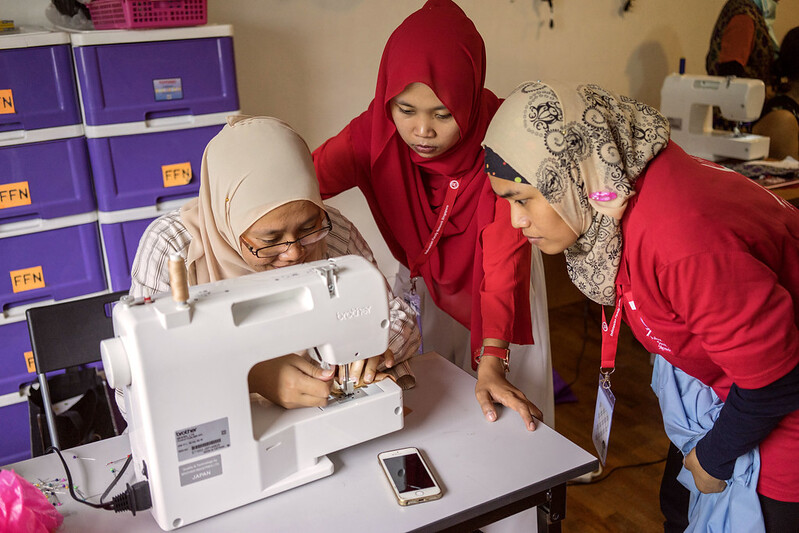Recommended
Micro and small businesses owned by women in low-income and middle-income countries that were disadvantaged to begin with when compared with men-owned businesses were hit especially hard by the COVID-19 pandemic—and need to be front and center in economic recovery programs.
Fortunately, thanks to a surge of gender and development research in the past decade, we have a much better idea of the constraints these businesses face and the actions that can work to alleviate them and empower women economically. At CGD we have contributed to this research with synthesis reviews and field research.
Key findings from new evidence: Sound household investment strategies, mindsets matter, and business training works
Compelling new findings, some which upend earlier views about what works to empower businesswomen in developing countries, reveal that:
Women are as capable as men of making sound business investment decision.
Earlier studies in Ghana, India, and Sri Lanka showed that returns to capital were lower for women than for men, suggesting that women were worse businesspeople. A reanalysis of this data, however, showed that this was the result of women investing less capital in their businesses. And the reason for this investment strategy is simple and rational: in households with more than one business, women channeled some of their capital to the highest-return enterprise within the household, often operated by men. If the objective is to grow women’s businesses by providing capital infusions, programs can nudge women to invest more of their capital in their own businesses by making accessible capital in-kind (and less likely to be easily divided) or providing access to individual accounts through mobile banking (where transactions are more private and less subject to pressures from others).
Mindsets matter, and soft skills training that boosts self-confidence and aspirations contribute to increased profits for businesswomen.
Soft skills training increased women’s profits and empowerment in Togo. A cash grant and a psychosocial intervention added to a cash transfer program opened pathways out of extreme poverty for women in Niger, increasing business activity, profits, and empowerment. In a more extreme example of how mindsets matter for economic empowerment, treating pre-natal depression with psychotherapy (through 16 home visits from community health workers) in rural Pakistan had a large impact on these mothers’ economic decision-making and financial empowerment seven years later.
Business training programs can work and increase profits of micro and small businesses.
This new, more unequivocal review of the evidence counters earlier views that questioned how useful these programs were and shows that streamlined business training programs increase business profits (by a small but significant 5 to 10 percent on average). Further, delivering a quality program that is gender-informed improves the effectiveness of training (increasing profits by 15 percent on average), although it may take time for impacts to appear. This notwithstanding, the new evidence also reaffirms that more complex “bundled” economic inclusion programs that seek to address the multiple constraints of the very poor, including capital, business, and soft skills constraints, as well as mindsets, maybe more taxing to implement but work and can be transformative.
Business training combined with mobile banking increased businesswomen’s profits in Indonesia, but with a delay
Adding to the new knowledge presented above, a year ago we blogged about results from a study that looked at what happens over time to Indonesian women owners of very small businesses that were exposed to a supply- and demand-side intervention. On the supply side, bank agents were offered high or low incentives to increase the uptake and usage of a new mobile banking product among business owners. The demand-side intervention was a quality, gender-informed short financial and business literacy course offered to businesswomen (it consisted of four group sessions: one theoretical session averaging three hours long, and three short practice sessions). In a nutshell, we found that the positive effects of this intervention on women’s business profits and household income were significant, but these positive effects took time to appear: they start low, increase over time, and were projected to continue growing well beyond the last measure taken two years after the intervention began.
We now have taken an in depth look at the data from this research to better understand their trajectory and the mechanisms triggered by the intervention that explain the findings. Here’s what we’ve found:
- For these businesswomen, the intervention results in better business practices, increased business capital and increased women’s agency (measured by women’s reported participation in five household decisions) and they drive the positive impact on women’s business profits.
- Most of these positive impacts on women’s business profits emerge with a one-year delay, showing that the results of the “light” streamlined trainings and bank agent intervention took time to materialize for businesswomen.
- Increased business profits are the main driver of increased household income which again materializes only with a one-year delay. This underscores women’s preference to invest some of the business profits in household welfare.
- The gender-informed (and affirming) financial and business training had direct effects on women’s agency, which increased linearly over time.
Applying these results for promoting women’s economic empowerment
The new evidence reviewed here, including the Indonesia findings, underscore four main messages that have implications for improving women’s business profits and empowerment.
First, short quality, gender-informed financial and business training work to improve women’s business practices and promote an independent mindset. Thus, this type of gender-informed training should be a core component of economic recovery programs for women running micro and small businesses in developing countries (along with additional ‘bundled’ interventions depending on the size of the business and the level of gender-related constraints).
Second, smart design elements can aid in increasing businesswomen’s economic autonomy and empowerment. Mobile money and savings accounts that provide privacy and other design features that increase self-confidence and nudge businesswomen to invest in their own businesses should be considered in the design of economic recovery programs that target women owned businesses.
Third, particularly in the case of businesswomen, the household context matters, and evaluation research should measure the effects of interventions at both the enterprise and household levels to understand the mechanisms (or the channels through which interventions work for women) and to avoid underestimating the positive effects of women’s access to financial resources on the household as well as the business.
Finally, “light” interventions designed to improve women’s economic lives, like the supply and demand-side intervention in the Indonesia study, need to be tracked long enough for women to manifest new and beneficial behaviors. The results don’t happen overnight.
The last measure in the Indonesia study was a year before the COVID-19 pandemic disrupted lives and businesses everywhere. What happened to these positive outcome trajectories in the face of these disruptions is worth asking to design effective economic recovery programs. Investments in longitudinal research informed by a gender perspective are much needed to track the effects of economic empowerment-related interventions over a longer time frame, to better understand the gender-specific effects of crises and women’s adaptive responses, and to explore how economic empowerment unfolds and what sustains it.
Disclaimer
CGD blog posts reflect the views of the authors, drawing on prior research and experience in their areas of expertise. CGD is a nonpartisan, independent organization and does not take institutional positions.






